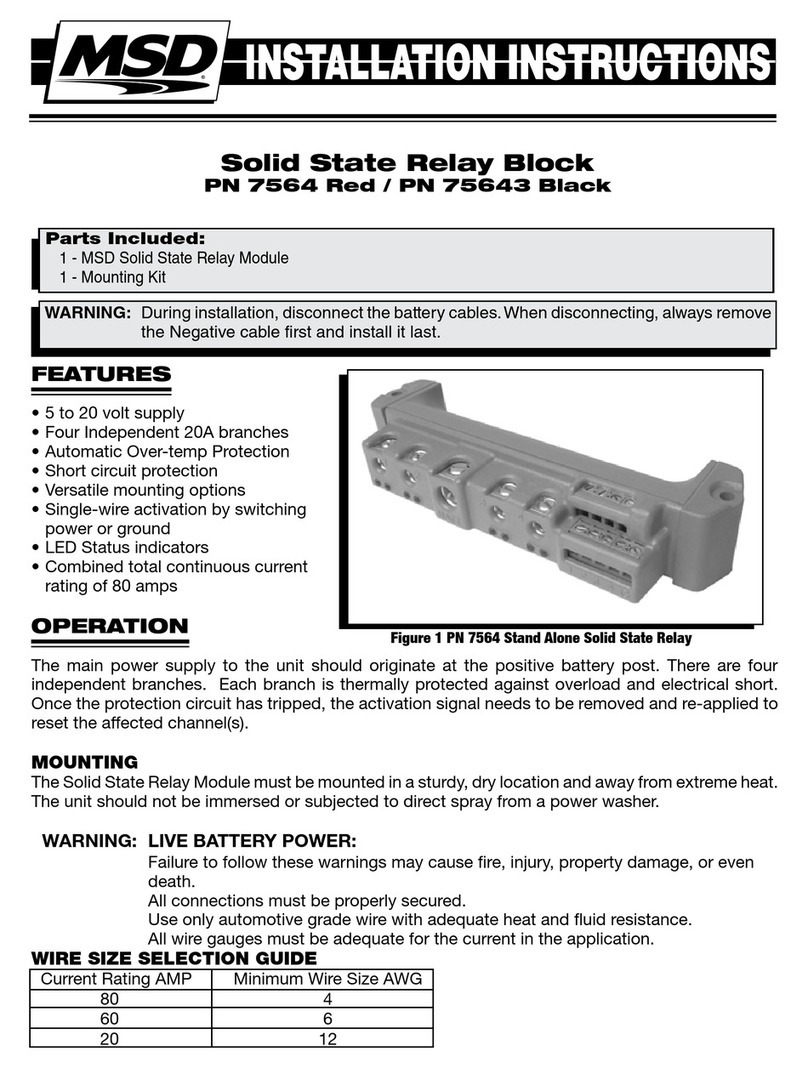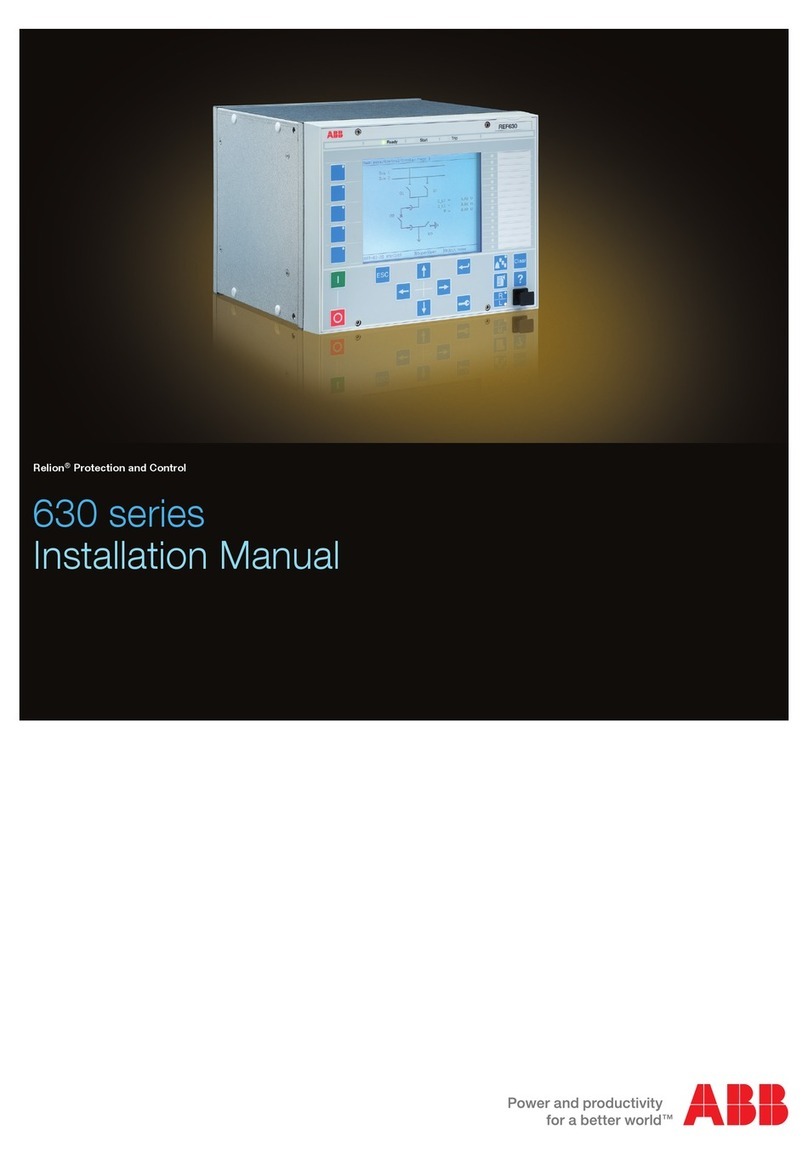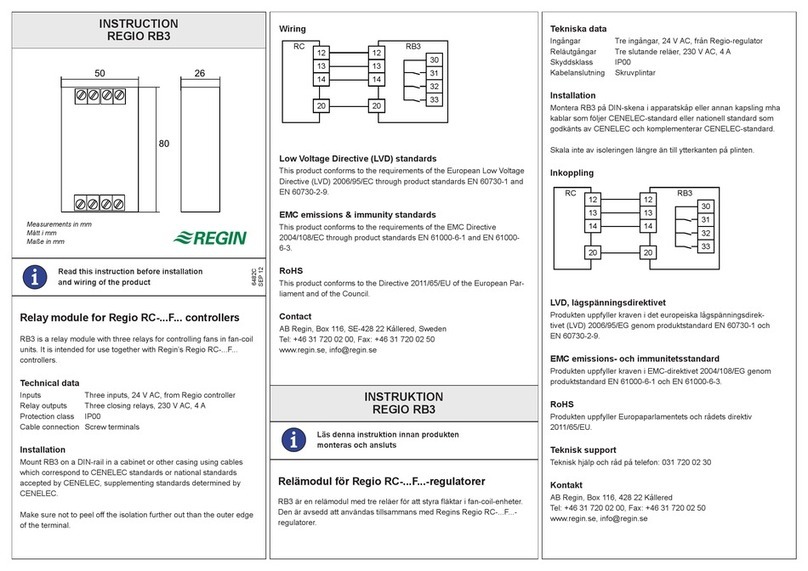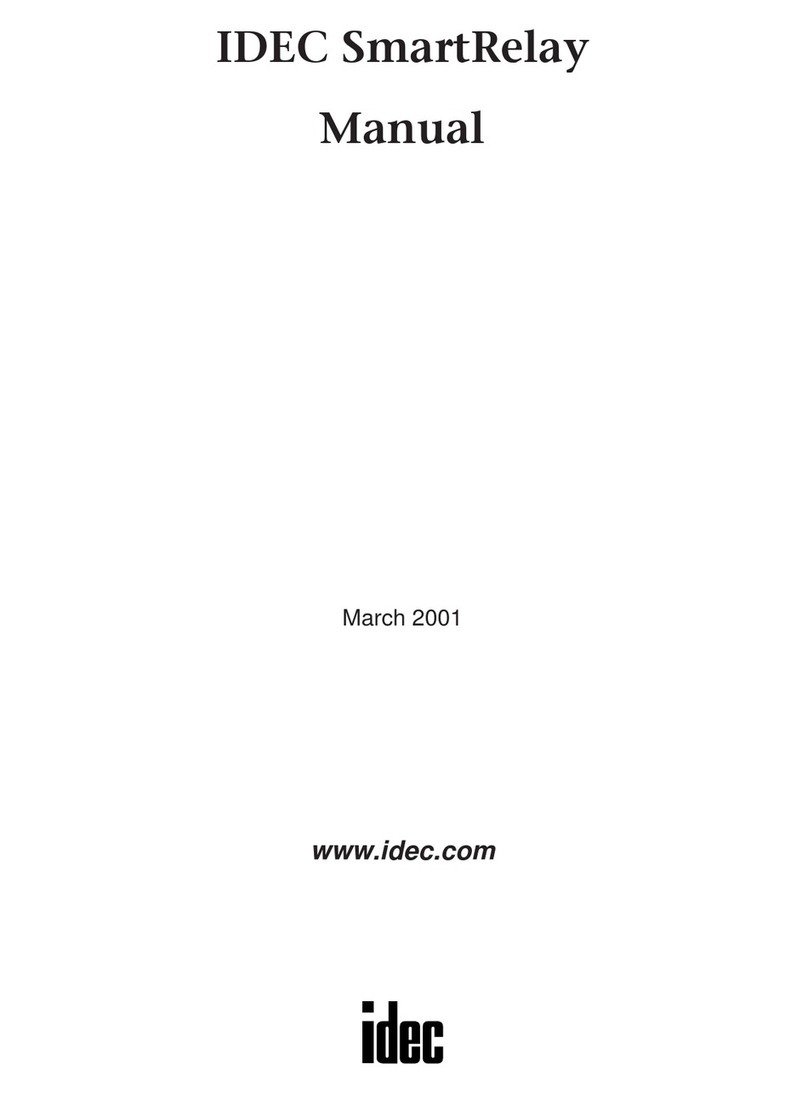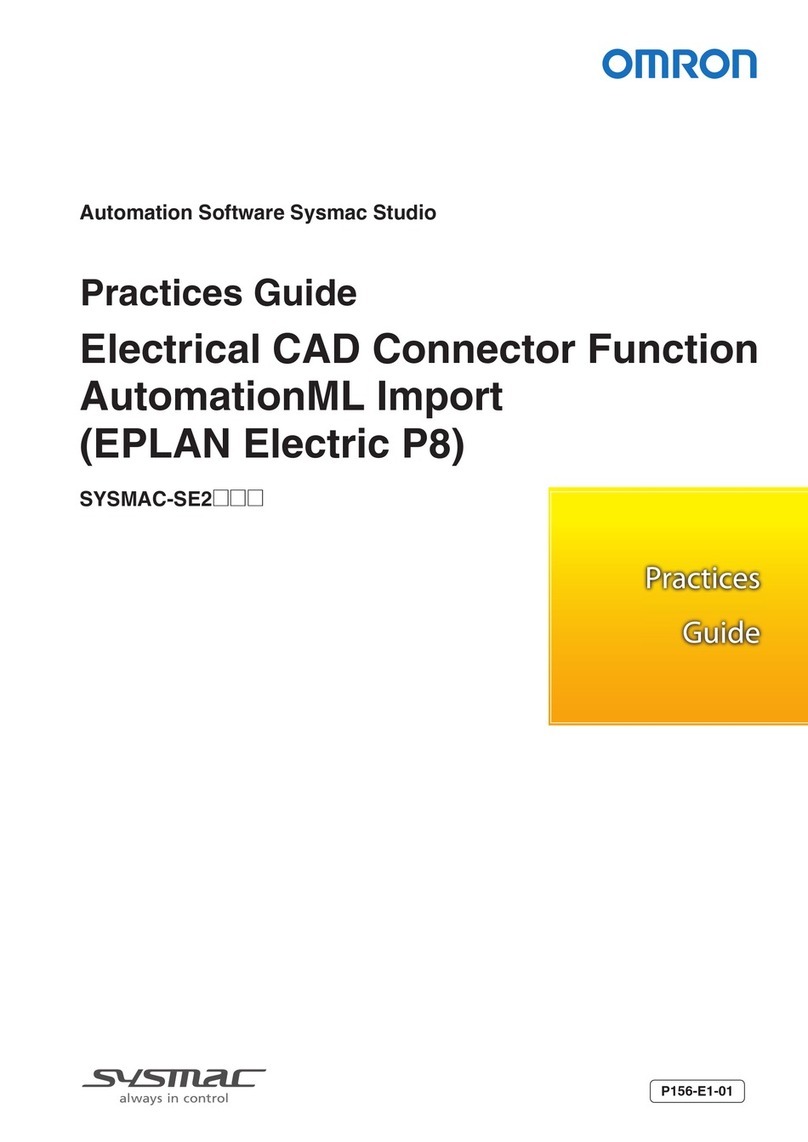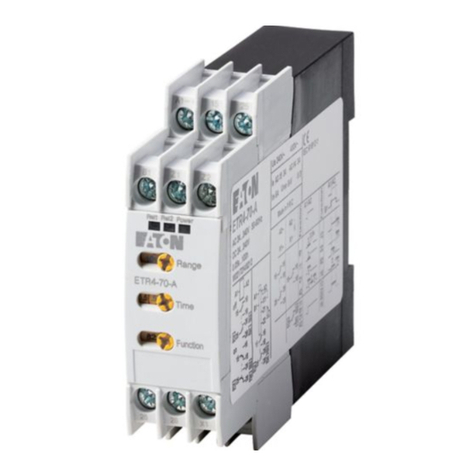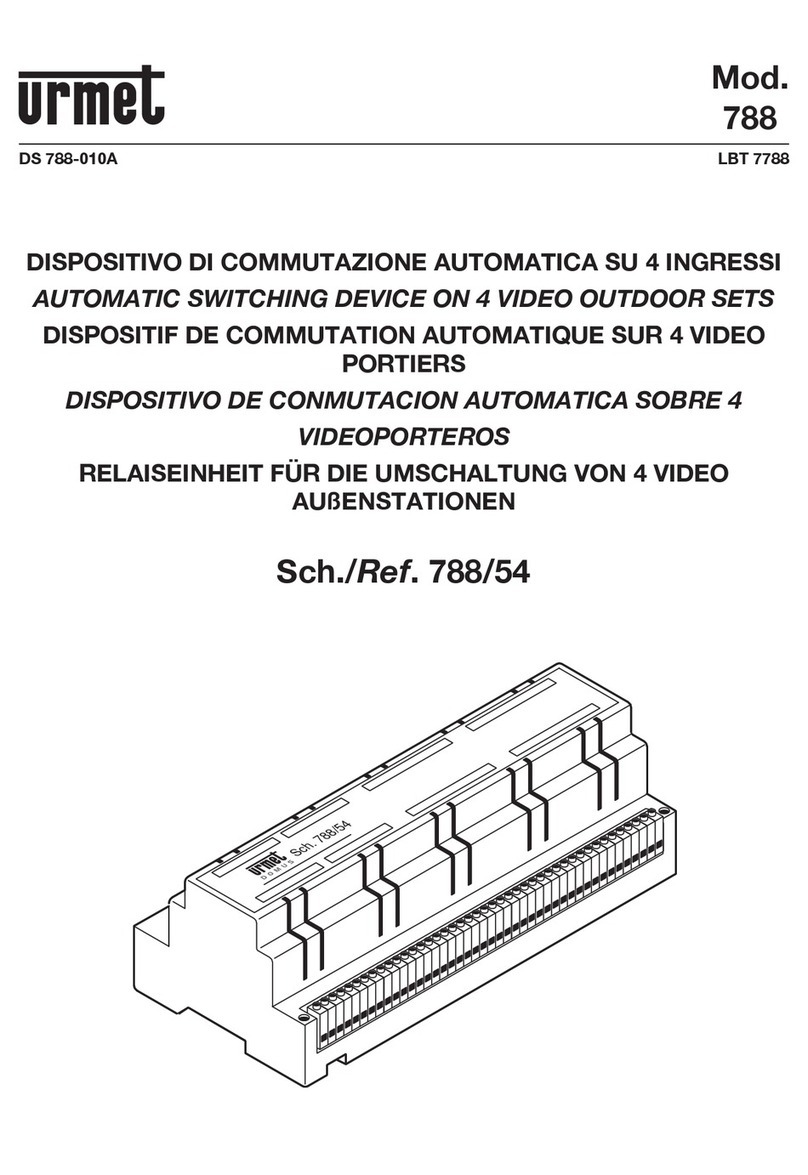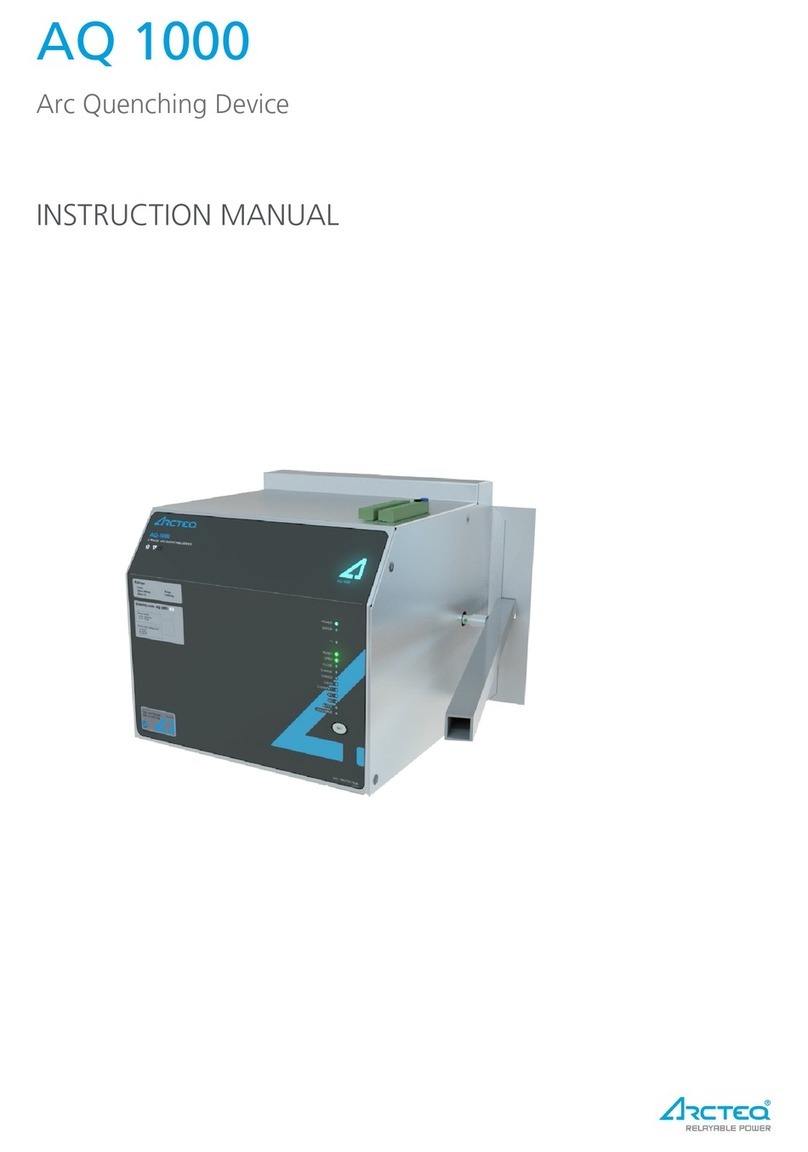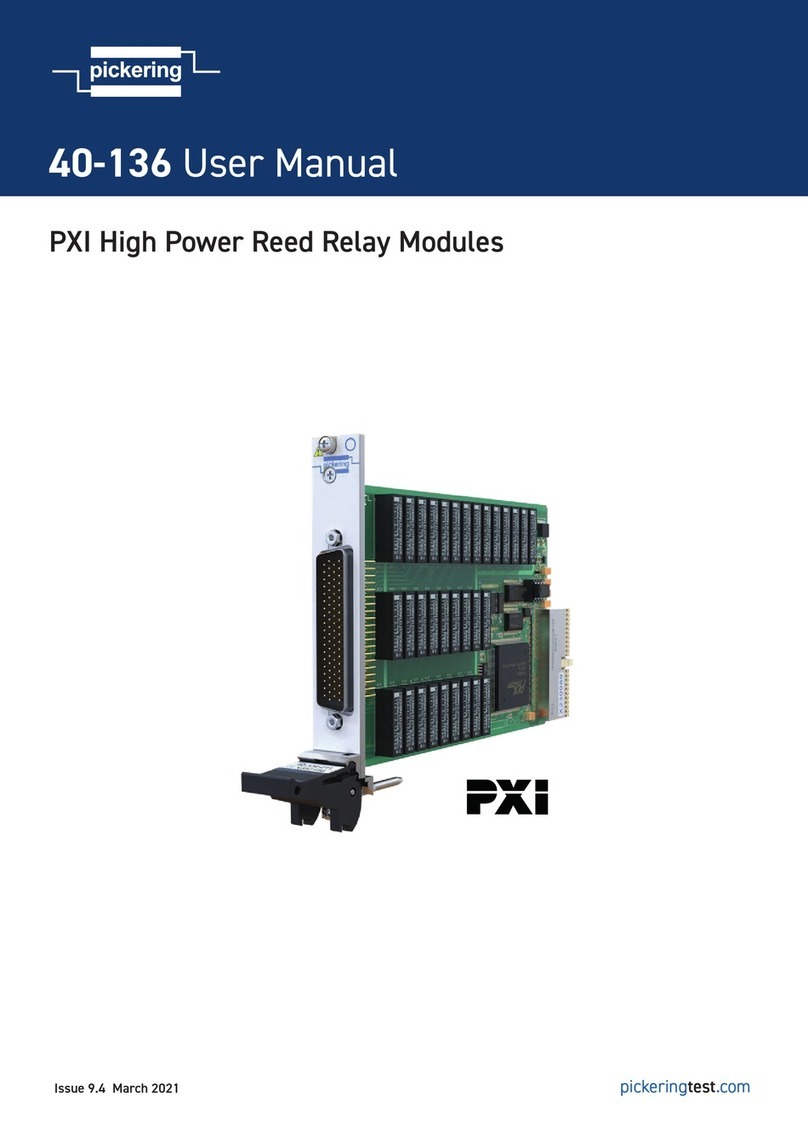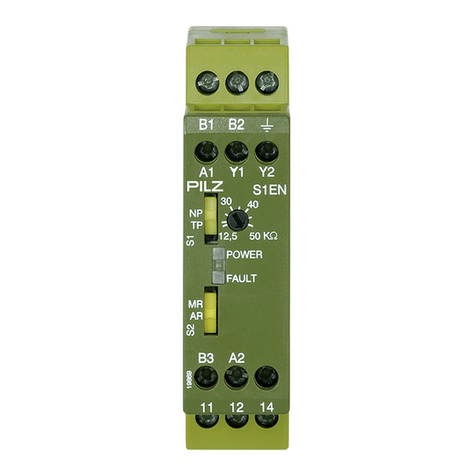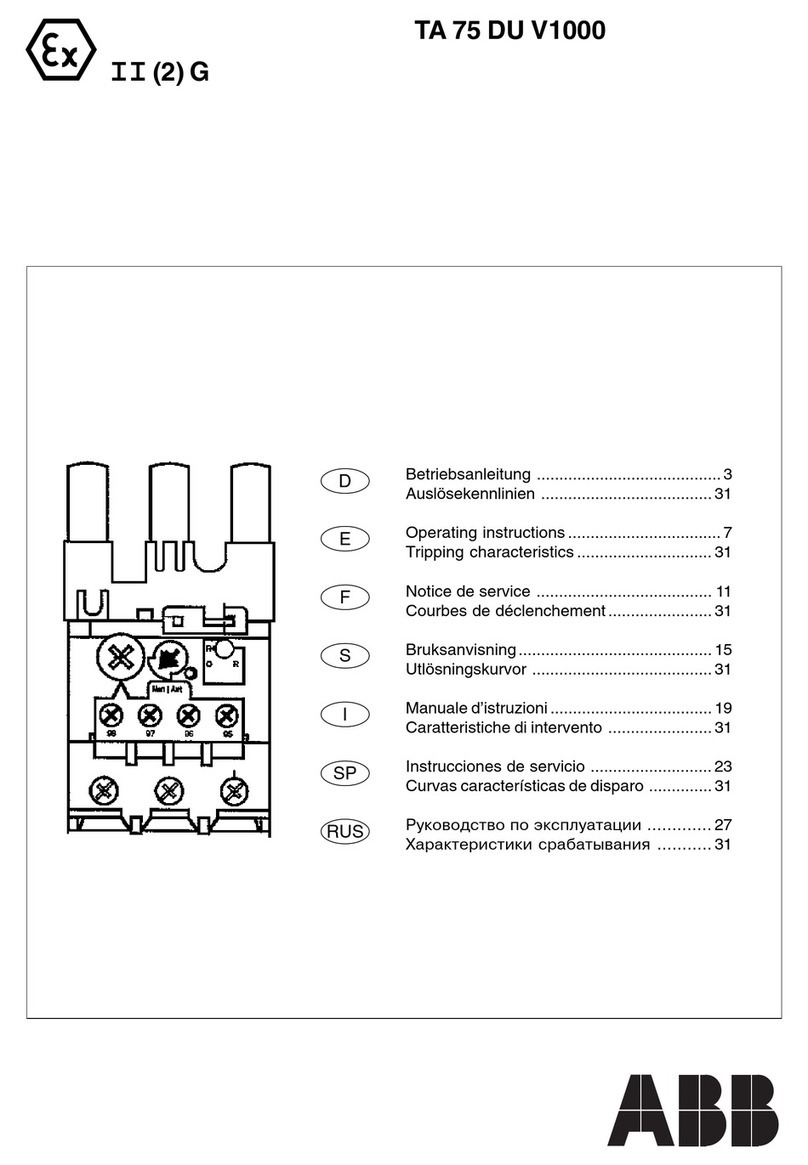GE Multilin 469 User manual

Digital Energy
Multilin
469 Motor Management
Relay
Instruction Manual
Software Revision: 5.0x
Manual P/N: 1601-0122-A8
Manual Order Code: GEK-106474G
Copyright © 2009 GE Multilin
GE Multilin
215 Anderson Avenue, Markham, Ontario
Canada L6E 1B3
Tel: (905) 294-6222 Fax: (905) 201-2098
Internet: http://www.GEmultilin.com
*1601-0122-A8*
GE Multilin's Quality Management
System is registered to
ISO9001:2000
QMI # 005094
UL # A3775

© 2009 GE Multilin Incorporated. All rights reserved.
GE Multilin 469 Motor Management Relay instruction manual for revision 5.0x.
469 Motor Management Relay, is a registered trademark of GE Multilin Inc.
The contents of this manual are the property of GE Multilin Inc. This documentation is
furnished on license and may not be reproduced in whole or in part without the permission
of GE Multilin. The content of this manual is for informational use only and is subject to
change without notice.
Part numbers contained in this manual are subject to change without notice, and should
therefore be verified by GE Multilin before ordering.
Part number: 1601-0122-A8 (September 2009)

TOC TABLE OF CONTENTS
469 MOTOR MANAGEMENT RELAY – INSTRUCTION MANUAL TOC–I
Table of Contents
1: GETTING STARTED IMPORTANT PROCEDURES ............................................................................. 1-1
CAUTIONS AND WARNINGS ............................................................................................... 1-1
INSPECTION CHECKLIST ...................................................................................................... 1-1
MANUAL ORGANIZATION ................................................................................................... 1-2
USING THE RELAY ............................................................................................ 1-3
MENU NAVIGATION ............................................................................................................. 1-3
PANEL KEYING EXAMPLE .................................................................................................... 1-8
CHANGING SETTINGS ...................................................................................... 1-9
INTRODUCTION ..................................................................................................................... 1-9
THE HELP KEY .................................................................................................................... 1-10
NUMERICAL SETTINGS ........................................................................................................ 1-10
ENUMERATION SETTINGS ................................................................................................... 1-11
OUTPUT RELAY SETTINGS .................................................................................................. 1-15
TEXT SETTINGS ..................................................................................................................... 1-15
APPLICATION EXAMPLE ................................................................................. 1-17
DESCRIPTION ........................................................................................................................ 1-17
INSTRUMENT TRANSFORMER DATA ................................................................................... 1-25
MOTOR PROTECTION .......................................................................................................... 1-25
S2 SYSTEM SETTINGS ......................................................................................................... 1-30
S3 DIGITAL INPUTS SETTINGS ........................................................................................... 1-32
S5 THERMAL MODEL .......................................................................................................... 1-33
S6 CURRENT ELEMENTS ..................................................................................................... 1-33
S7 MOTOR STARTING ......................................................................................................... 1-35
S8 RTD TEMPERATURE ...................................................................................................... 1-35
OTHER SETTINGS ................................................................................................................. 1-36
INSTALLATION .................................................................................................. 1-38
TESTING ................................................................................................................................ 1-38
2: INTRODUCTION OVERVIEW .......................................................................................................... 2-1
DESCRIPTION ........................................................................................................................ 2-1
ORDERING INFORMATION ................................................................................................... 2-4
ORDER CODES ..................................................................................................................... 2-5
EXAMPLE ORDER CODES .................................................................................................... 2-5
ACCESSORIES ....................................................................................................................... 2-5
SPECIFICATIONS ............................................................................................... 2-6
INPUTS .................................................................................................................................. 2-6
OUTPUTS ...............................................................................................................................2-7
PROTECTION ......................................................................................................................... 2-8
DIGITAL INPUTS ................................................................................................................... 2-10
MONITORING ........................................................................................................................ 2-11
POWER SUPPLY ................................................................................................................... 2-13
CPU ...................................................................................................................................... 2-13
TESTING ................................................................................................................................ 2-13
CERTIFICATION ..................................................................................................................... 2-14
PHYSICAL .............................................................................................................................. 2-15
ENVIRONMENTAL ................................................................................................................. 2-15
LONG-TERM STORAGE ........................................................................................................ 2-15

TOC–II 469 MOTOR MANAGEMENT RELAY – INSTRUCTION MANUAL
TABLE OF CONTENTS
3: INSTALLATION MECHANICAL INSTALLATION ....................................................................... 3-1
DESCRIPTION ........................................................................................................................ 3-1
PRODUCT IDENTIFICATION .................................................................................................. 3-2
INSTALLATION ....................................................................................................................... 3-3
UNIT WITHDRAWAL AND INSERTION ................................................................................ 3-5
ETHERNET CONNECTION .................................................................................................... 3-7
DEVICENET CONNECTION .................................................................................................. 3-8
TERMINAL LOCATIONS ........................................................................................................ 3-9
TERMINAL LIST ..................................................................................................................... 3-9
ELECTRICAL INSTALLATION ......................................................................... 3-11
TYPICAL WIRING .................................................................................................................. 3-11
DESCRIPTION ........................................................................................................................ 3-12
CONTROL POWER ................................................................................................................ 3-12
CURRENT INPUTS ................................................................................................................. 3-13
VOLTAGE INPUTS ................................................................................................................. 3-17
DIGITAL INPUTS ................................................................................................................... 3-18
ANALOG INPUTS .................................................................................................................. 3-19
ANALOG OUTPUTS .............................................................................................................. 3-19
RTD SENSOR CONNECTIONS ............................................................................................ 3-20
OUTPUT RELAYS .................................................................................................................. 3-22
DRAWOUT INDICATOR ........................................................................................................ 3-24
RS485 COMMUNICATIONS PORTS ................................................................................... 3-24
DIELECTRIC STRENGTH ....................................................................................................... 3-25
2-SPEED MOTOR WIRING .................................................................................................. 3-27
4: INTERFACES FACEPLATE INTERFACE .................................................................................. 4-1
DESCRIPTION ........................................................................................................................ 4-1
DISPLAY ................................................................................................................................. 4-1
LED INDICATORS ................................................................................................................. 4-2
RS232 PORT ....................................................................................................................... 4-3
KEYPAD ................................................................................................................................. 4-4
SETTINGS ENTRY .................................................................................................................. 4-6
DIAGNOSTIC MESSAGES ..................................................................................................... 4-7
SELF-TEST WARNINGS ....................................................................................................... 4-8
FLASH MESSAGES ................................................................................................................ 4-9
ENERVISTA 469 SETUP SOFTWARE INTERFACE ....................................... 4-10
OVERVIEW ............................................................................................................................ 4-10
HARDWARE ........................................................................................................................... 4-11
INSTALLING THE ENERVISTA 469 SETUP SOFTWARE .................................................... 4-13
CONNECTING ENERVISTA 469 SETUP TO THE RELAY ............................. 4-16
CONFIGURING SERIAL COMMUNICATIONS ....................................................................... 4-16
USING THE QUICK CONNECT FEATURE ............................................................................ 4-17
CONFIGURING ETHERNET COMMUNICATIONS ................................................................. 4-18
CONNECTING TO THE RELAY .............................................................................................. 4-19
WORKING WITH SETTINGS AND SETTINGS FILES .................................... 4-22
ENGAGING ADEVICE ........................................................................................................... 4-22
ENTERING SETTINGS ............................................................................................................ 4-22
FILE SUPPORT ...................................................................................................................... 4-23
USING SETTINGS FILES ....................................................................................................... 4-23
UPGRADING RELAY FIRMWARE ................................................................... 4-35
DESCRIPTION ........................................................................................................................ 4-35
SAVING SETTINGS TO AFILE .............................................................................................. 4-35

TOC TABLE OF CONTENTS
469 MOTOR MANAGEMENT RELAY – INSTRUCTION MANUAL TOC–III
LOADING NEW FIRMWARE ................................................................................................. 4-35
ADVANCED ENERVISTA 469 SETUP FEATURES ........................................ 4-38
TRIGGERED EVENTS ............................................................................................................. 4-38
WAVEFORM CAPTURE (TRACE MEMORY) ......................................................................... 4-38
PHASORS .............................................................................................................................. 4-40
TRENDING (DATA LOGGER) ................................................................................................ 4-42
EVENT RECORDER ............................................................................................................... 4-45
MODBUS USER MAP ........................................................................................................... 4-46
VIEWING ACTUAL VALUES ................................................................................................. 4-46
USING ENERVISTA VIEWPOINT WITH THE 469 ......................................... 4-49
PLUG AND PLAY EXAMPLE ................................................................................................. 4-49
5: SETTINGS OVERVIEW .......................................................................................................... 5-1
SETTINGS MESSAGE MAP ................................................................................................... 5-1
TRIPS, ALARMS, AND BLOCKS ............................................................................................ 5-6
RELAY ASSIGNMENT PRACTICES ........................................................................................ 5-7
S1 469 SETUP ....................................................................................................... 5-8
PASSCODE ............................................................................................................................ 5-8
PREFERENCES ....................................................................................................................... 5-9
COMMUNICATIONS .............................................................................................................. 5-10
REAL TIME CLOCK ............................................................................................................... 5-13
DEFAULT MESSAGES ........................................................................................................... 5-13
MESSAGE SCRATCHPAD ...................................................................................................... 5-14
CLEAR DATA ......................................................................................................................... 5-15
INSTALLATION ....................................................................................................................... 5-16
S2 SYSTEM SETUP ............................................................................................. 5-17
CURRENT SENSING .............................................................................................................. 5-17
VOLTAGE SENSING .............................................................................................................. 5-19
POWER SYSTEM ................................................................................................................... 5-19
COMMUNICATIONS CONTROL ............................................................................................ 5-20
REDUCED VOLTAGE ............................................................................................................. 5-21
S3 DIGITAL INPUTS ........................................................................................... 5-24
DESCRIPTION ........................................................................................................................ 5-24
STARTER STATUS ................................................................................................................. 5-25
ASSIGNABLE INPUTS 1(4) ................................................................................................... 5-25
S4 OUTPUT RELAYS .......................................................................................... 5-34
DESCRIPTION ........................................................................................................................ 5-34
RELAY RESET MODE ............................................................................................................ 5-34
FORCE OUTPUT RELAY ....................................................................................................... 5-35
S5 THERMAL MODEL ....................................................................................... 5-36
MOTOR THERMAL LIMITS ................................................................................................... 5-36
THERMAL MODEL ................................................................................................................ 5-38
OVERLOAD CURVE SETUP .................................................................................................. 5-39
S6 CURRENT ELEMENTS ................................................................................. 5-59
SHORT CIRCUIT TRIP ........................................................................................................... 5-59
OVERLOAD ALARM .............................................................................................................. 5-60
MECHANICAL JAM ............................................................................................................... 5-60
UNDERCURRENT .................................................................................................................. 5-61
CURRENT UNBALANCE ....................................................................................................... 5-62
GROUND FAULT ................................................................................................................... 5-63
PHASE DIFFERENTIAL .......................................................................................................... 5-64
S7 MOTOR STARTING ....................................................................................... 5-66
ACCELERATION TIMER ......................................................................................................... 5-66

TOC–IV 469 MOTOR MANAGEMENT RELAY – INSTRUCTION MANUAL
TABLE OF CONTENTS
START INHIBIT ...................................................................................................................... 5-66
JOGGING BLOCK .................................................................................................................. 5-67
RESTART BLOCK ................................................................................................................... 5-69
S8 RTD TEMPERATURE .................................................................................... 5-70
RTD TYPES ........................................................................................................................... 5-70
RTDS1 TO 6 ....................................................................................................................... 5-71
RTDS7 TO 10 ..................................................................................................................... 5-72
RTD 11 ................................................................................................................................ 5-73
RTD 12 ................................................................................................................................ 5-74
OPEN RTD SENSOR ............................................................................................................ 5-75
RTD SHORT/LOW TEMP .................................................................................................... 5-75
S9 VOLTAGE ELEMENTS ................................................................................. 5-76
UNDERVOLTAGE ................................................................................................................... 5-76
OVERVOLTAGE ...................................................................................................................... 5-78
PHASE REVERSAL ................................................................................................................. 5-78
FREQUENCY .......................................................................................................................... 5-79
S10 POWER ELEMENTS .................................................................................... 5-80
POWER MEASUREMENT CONVENTIONS ........................................................................... 5-80
POWER FACTOR ................................................................................................................... 5-81
REACTIVE POWER ................................................................................................................ 5-82
UNDERPOWER ...................................................................................................................... 5-83
REVERSE POWER ................................................................................................................. 5-84
TORQUE SETUP .................................................................................................................... 5-84
OVERTORQUE ....................................................................................................................... 5-85
S11 MONITORING .............................................................................................. 5-86
TRIP COUNTER ..................................................................................................................... 5-86
STARTER FAILURE ................................................................................................................ 5-86
DEMAND ...............................................................................................................................5-87
PULSE OUTPUT .................................................................................................................... 5-89
S12 ANALOG INPUTS/OUTPUTS ..................................................................... 5-91
ANALOG OUTPUTS 1 TO 4 ................................................................................................. 5-91
ANALOG INPUTS 1 TO 4 ..................................................................................................... 5-93
ANALOG INPUT DIFF 1-2 ................................................................................................... 5-95
ANALOG INPUT DIFF 3-4 ................................................................................................... 5-96
S13 469 TESTING ................................................................................................. 5-98
SIMULATION MODE ............................................................................................................. 5-98
PRE-FAULT SETUP ............................................................................................................... 5-99
FAULT SETUP ........................................................................................................................ 5-100
TEST OUTPUT RELAYS ......................................................................................................... 5-101
TEST ANALOG OUTPUTS ..................................................................................................... 5-101
COMM PORT MONITOR ....................................................................................................... 5-102
GE MULTILIN USE ONLY .................................................................................................... 5-102
S14 TWO-SPEED MOTOR .................................................................................. 5-103
DESCRIPTION ........................................................................................................................ 5-103
SPEED2 UNDERCURRENT ................................................................................................... 5-107
SPEED2 ACCELERATION ...................................................................................................... 5-107
6: ACTUAL VALUES OVERVIEW .......................................................................................................... 6-1
ACTUAL VALUES MAP ......................................................................................................... 6-1
DESCRIPTION ........................................................................................................................ 6-3
A1 STATUS .......................................................................................................... 6-4
NETWORK STATUS ............................................................................................................... 6-4
MOTOR STATUS ................................................................................................................... 6-5

TOC TABLE OF CONTENTS
469 MOTOR MANAGEMENT RELAY – INSTRUCTION MANUAL TOC–V
LAST TRIP DATA ................................................................................................................... 6-5
ALARM STATUS .................................................................................................................... 6-7
START BLOCKS ..................................................................................................................... 6-9
DIGITAL INPUTS ................................................................................................................... 6-9
REAL TIME CLOCK ............................................................................................................... 6-10
A2 METERING DATA ......................................................................................... 6-11
CURRENT METERING ........................................................................................................... 6-11
TEMPERATURE ...................................................................................................................... 6-12
VOLTAGE METERING ........................................................................................................... 6-13
SPEED .................................................................................................................................... 6-13
POWER METERING .............................................................................................................. 6-14
DEMAND METERING ............................................................................................................ 6-15
ANALOG INPUTS .................................................................................................................. 6-15
PHASORS .............................................................................................................................. 6-16
A3 LEARNED DATA ........................................................................................... 6-27
MOTOR STARTING ............................................................................................................... 6-27
AVERAGE MOTOR LOAD ..................................................................................................... 6-28
RTD MAXIMUMS ................................................................................................................. 6-28
ANALOG INPUT MIN/MAX ................................................................................................. 6-29
A4 MAINTENANCE ............................................................................................ 6-30
TRIP COUNTERS ................................................................................................................... 6-30
GENERAL COUNTERS .......................................................................................................... 6-31
TIMERS .................................................................................................................................. 6-32
A5 EVENT RECORDER ...................................................................................... 6-33
EVENT 01 TO EVENT 256 .................................................................................................. 6-33
A6 PRODUCT INFO ............................................................................................ 6-36
469 MODEL INFORMATION ............................................................................................... 6-36
CALIBRATION INFORMATION .............................................................................................. 6-36
DIAGNOSTICS ..................................................................................................... 6-37
DIAGNOSTIC MESSAGES ..................................................................................................... 6-37
FLASH MESSAGES ................................................................................................................ 6-38
7: TESTING OVERVIEW .......................................................................................................... 7-1
TEST SETUP .......................................................................................................................... 7-1
HARDWARE FUNCTIONAL TESTING ............................................................ 7-3
PHASE CURRENT ACCURACY TEST .................................................................................... 7-3
VOLTAGE INPUT ACCURACY TEST ..................................................................................... 7-3
GROUND AND DIFFERENTIAL ACCURACY TEST ............................................................... 7-4
GE MULTILIN 50:0.025 GROUND ACCURACY TEST ..................................................... 7-5
RTD ACCURACY TEST ......................................................................................................... 7-5
DIGITAL INPUTS AND TRIP COIL SUPERVISION ................................................................ 7-7
ANALOG INPUTS AND OUTPUTS ........................................................................................ 7-8
OUTPUT RELAYS .................................................................................................................. 7-10
ADDITIONAL FUNCTIONAL TESTING .......................................................... 7-11
OVERLOAD CURVE TEST ..................................................................................................... 7-11
POWER MEASUREMENT TEST ............................................................................................ 7-11
UNBALANCE TEST ................................................................................................................ 7-12
VOLTAGE PHASE REVERSAL TEST ...................................................................................... 7-13
SHORT CIRCUIT TEST .......................................................................................................... 7-14

TOC–VI 469 MOTOR MANAGEMENT RELAY – INSTRUCTION MANUAL
TABLE OF CONTENTS
APPENDIX TWO-PHASE CT CONFIGURATION ................................................................ A-1
DESCRIPTION ........................................................................................................................ A-1
COOL TIME CONSTANTS ................................................................................. A-4
SELECTION OF COOL TIME CONSTANTS ........................................................................... A-4
CURRENT TRANSFORMERS ............................................................................ A-6
GROUND FAULT CTSFOR 50:0.025 A CT .................................................................... A-6
GROUND FAULT CTSFOR 5ASECONDARY CT ............................................................. A-8
PHASE CTS........................................................................................................................... A-8
EU DECLARATION OF CONFORMITY ........................................................... A-10
EU DECLARATION OF CONFORMITY ................................................................................. A-10
CHANGE NOTES ................................................................................................. A-11
REVISION HISTORY .............................................................................................................. A-11
CHANGES TO THE 469 MANUAL ...................................................................................... A-11
GE MULTILIN WARRANTY .............................................................................. A-13
WARRANTY STATEMENT ..................................................................................................... A-13

469 MOTOR MANAGEMENT RELAY – INSTRUCTION MANUAL 1–1
469 Motor Management Relay
Chapter 1: Getting Started
Digital Energy
Multilin
Getting Started
1.1 Important Procedures
1.1.1 Cautions and Warnings
Please read this chapter to guide you through the initial setup of your new relay.
Before attempting to install or use the relay, it is imperative that all
WARNINGS and CAUTIONS in this manual are reviewed to help
prevent personal injury, equipment damage, and/or downtime.
1.1.2 Inspection Checklist
• Open the relay packaging and inspect the unit for physical damage.
• View the rear nameplate and verify that the correct model has been ordered.
• Ensure that the following items are included:
– Instruction Manual
– GE EnerVista CD (includes software and relay documentation)
– mounting screws
• For product information, instruction manual updates, and the latest software updates,
please visit the GE Multilin website at http://www.GEmultilin.com.
Note If there is any noticeable physical damage, or any of the contents listed are missing, please
contact GE Multilin immediately.
WARNING

1–2 469 MOTOR MANAGEMENT RELAY – INSTRUCTION MANUAL
CHAPTER 1: GETTING STARTED
1.1.3 Manual Organization
Reading a lengthy instruction manual on a new product is not a task most people enjoy. To
speed things up, this introductory chapter provides a step-by-step tutorial for a simple
motor application. Important wiring considerations and precautions discussed in Electrical
Installation on page 3–11 should be observed for reliable operation. Detailed information
regarding accuracy, output relay contact ratings, and so forth are detailed in Specifications
on page 2–6. The remainder of this manual should be read and kept for reference to
ensure maximum benefit from the 469 Motor Management Relay. For further information,
please consult your local sales representative or the factory. Comments about new
features or modifications for your specific requirements are welcome and encouraged.
settings and actual values are indicated as follows in the manual:
A3 LEARNED DATA ZV AVERAGE MOTOR LOAD ZAVERAGE MOTOR LOAD LEARNED
This ‘path representation’ illustrates the location of an specific actual value or settings with
regards to its previous menus and sub-menus. In the example above, the AVERAGE MOTOR
LOAD LEARNED actual value is shown to be an item in the AVERAGE MOTOR LOAD sub-
menu, which itself is an item in the A3 LEARNED DATA menu, which is an item of ACTUAL
VALUES.
Sub-menu levels are entered by pressing the MESSAGE Xor ENTER key. When inside a
submenu, the WMESSAGE or ESCAPE key returns to the previous sub-menu. The
MESSAGE Tand MESSAGE Skeys are used to scroll through the settings in a sub-menu.
The display indicates which keys can be used at any given point.

CHAPTER 1: GETTING STARTED
469 MOTOR MANAGEMENT RELAY – INSTRUCTION MANUAL 1–3
1.2 Using the Relay
1.2.1 Menu Navigation
The relay has three types of display messages: actual value, settings, and target messages.
A summary of the menu structure for settings and actual values can be found at the
beginning of chapters 5 and 6, respectively.
Settings are programmable settings entered by the user. These types of messages are
located within a menu structure that groups the information into categories. Navigating
the menu structure is described below.
Actual values include the following information:
1. Motor and System Status:
a. Motor status either stopped, starting, or running. It includes values such as motor
load, thermal capacity used, motor speed, and instantaneous values of power
system quantities.
b. The status of digital inputs.
c. Last trip information, including values such as cause of last trip, time and date of
trip, motor speed and load at the time of trip, pre-trip temperature measure-
ments, pre-trip analog inputs values, and pre-trip instantaneous values of power
system quantities.
d. Active alarms.
e. Relay date and time.
f. Present blocking conditions.
g. General system status indication including the status of output relays, active
pickup, alarm and trip conditions.
2. Metering Data:
a. Instantaneous current measurements including phase, differential, unbalance,
ground, average, and motor load.
b. RTD Temperatures including hottest RTDs.
c. Instantaneous phase to phase and phase to ground voltages (depending on the
VT connections), average voltage, and system frequency.
d. Motor Speed
e. Power Quantities including apparent, real and reactive power.
f. Current and power demand including peak values.
g. Analog inputs
h. Vector information.
3. Motor Learned Data:
a. Learned and last acceleration time.
b. Learned and last starting current.

1–4 469 MOTOR MANAGEMENT RELAY – INSTRUCTION MANUAL
CHAPTER 1: GETTING STARTED
c. Learned and last starting capacity.
d. Average motor load.
4. Maintenance data. This is useful statistical information that may be used for
preventive maintenance. It includes:
a. Trip counters
b. General counter such as number of motor starts, number of emergency restarts,
number of starter operations, digital counter for other purposes not listed above.
c. Timers such as motor running hours, time between starts timer, and five start tim-
ers used to calculate the average start time of the motor.
5. RTD Learned Data, which includes the maximum temperature measured by each of
the 12 RTDs.
6. Event recorder downloading tool.
7. Product information including model number, firmware version, additional product
information, and calibration dates.
8. Oscillography downloading tool.
Alarm, trip conditions, diagnostics, and system flash messages are grouped under Target
Messages.
ZPress the MENU key to access the header of each menu, which will be
displayed in the following sequence:
To access settings,
ZPress the MENU key until the display shows the header of the Settings
menu.
ZPress the MESSAGE Xor ENTER key to display the header for the first
Settings page.
The Settings pages are numbered, have an ‘S’ prefix for easy
identification and have a name which provides a general idea of the
settings available in that page.
Pressing the MESSAGE Tand MESSAGE Skeys will scroll through all
the available Settings page headers. Settings page headers look as
follows:
SETTINGS [
Z]
ACTUAL
VALUES [Z]
TARGET
MESSAGES [Z]

CHAPTER 1: GETTING STARTED
469 MOTOR MANAGEMENT RELAY – INSTRUCTION MANUAL 1–5
To enter a given Settings page,
ZPress the MESSAGE Xor ENTER key.
ZPress the MESSAGE Tor MESSAGE Skeys to scroll through sub-page
headers until the required message is reached.
The end of a page is indicated by the message END OF PAGE. The
beginning of a page is indicated by the message TOP OF PAGE.
To access actual values,
ZPress the MENU key until the display shows the header of the actual
values menu.
ZPress the MESSAGE Xor ENTER key to display the header for the first
actual values page.
The actual values pages are numbered, have an ‘A’ prefix for easy
identification and have a name, which gives a general idea of the
information available in that page.
Pressing the MESSAGE Tor MESSAGE Skeys will scroll through all
the available actual values page headers. Actual values page headers
look as follows:
To enter a given actual values page,
ZPress the MESSAGE Xor ENTER key.
ZPress the MESSAGE Tor MESSAGE Skeys to scroll through sub-page
headers until the required message is reached.
The end of a page is indicated by the message END OF PAGE. The
beginning of a page is indicated by the message TOP OF PAGE.
Similarly, to access additional sub-pages,
ZPress the MESSAGE Xor ENTER key to enter the first sub-page,
ZPress the MESSAGE Tor MESSAGE Skeys to scroll through the
available sub-pages, until the desired message is reached.
The process is identical for both settings and actual values.
The following procedure illustrates the key sequence to access the Current Demand actual
values.
ZPress the MENU key until you reach the actual values main menu.
ZPress MESSAGE Xor ENTER key to enter the first actual values page.
SETTINGS [
Z]
S1 RELAY SETUP
ACTUAL
VALUES [Z]
A1 STATUS

1–6 469 MOTOR MANAGEMENT RELAY – INSTRUCTION MANUAL
CHAPTER 1: GETTING STARTED
ZPress the MESSAGE Tor MESSAGE Skey to scroll through pages,
until the A2 METERING DATA page appears.
ZPress the MESSAGE Xor ENTER key to display the first sub-page
heading for the Metering Data actual values page:
Pressing the MESSAGE Tor MESSAGE Skeys will scroll the display up and down
through the sub-page headers.
Pressing the WMESSAGE or ESCAPE key at any sub-page heading will return the
display to the heading of the corresponding settings or actual value page.
Pressing it again, will return the display to the main menu header.
ZPress the MESSAGE Tkey until the DEMAND METERING sub-page
heading appears.
At this point, pressing MESSAGE Xor ENTER key will display the messages under this
sub-page. If instead you press the MESSAGE Skey, it will return to the previous sub-
page heading. In this case,
When the symbols and [Z]appear on the top line, it indicates that additional sub-
pages are available and can be accessed by pressing the MESSAGE Xor ENTER key.
ZPress MESSAGE Xor ENTER while at the Demand Metering sub-page
heading to display the following:
ZPress WMESSAGE key to return to the Demand Metering sub-page
heading.
ACTUAL
VALUES [Z]
A2 METERING
DATA
CURRENT [
Z]
METERING
DEMAND [
Z]
METERING
POWER [
Z]
METERING
CURRENT
DEMAND: 0
Amps

CHAPTER 1: GETTING STARTED
469 MOTOR MANAGEMENT RELAY – INSTRUCTION MANUAL 1–7
ZPress the MESSAGE Tkey to display the next actual value of this sub-
page.
Actual values and settings messages always have a colon separating the
name of the value and the actual value or settings. This particular
message displays the current demand as measured by the relay.
The menu path to this value is shown as A2 METERING DATA ZV DEMAND METERING
ZCURRENT DEMAND. Settings and actual values messages are referred to in this
manner throughout the manual.
For example, the A3 LEARNED DATA ZMOTOR STARTING ZLEARNED ACCELERATION
TIME path representation describes the following key-press sequence:
ZPress the MENU key until the actual value header appears on the display,
MESSAGE Xor ENTER key,
ZPress the MESSAGE Tkey until the A3 LEARNED DATA message is
displayed.
ZPress the MESSAGE Xor ENTER key to display MOTOR STARTING
message.
ZPress the MESSAGE Xor ENTER key to reach the LEARNED
ACCELERATION TIME message and the corresponding actual value.
ZPress the MESSAGE Tkey to display the next actual value message as
shown below:
ZPress the MESSAGE Tor MESSAGE Skeys to scroll the display up and
down through all the actual value displays in this corresponding sub-
page.
ZPress the WMESSAGE key to reverse the process described above and
return the display to the previous level.
ZPress the WMESSAGE key twice to return to the A3 LEARNED DATA
page header.
LEARNED STARTING
CURRENT: 0 A
MOTOR [
Z]
STARTING
ACTUAL
VALUES [Z]
A3 LEARNED DATA

1–8 469 MOTOR MANAGEMENT RELAY – INSTRUCTION MANUAL
CHAPTER 1: GETTING STARTED
1.2.2 Panel Keying Example
The following figure gives a specific example of how the keypad is used to navigate
through the menu structure. Specific locations are referred to throughout this manual by
using a ‘path representation’. The example shown in the figure gives the key presses
required to read the learned starting current denoted by the path A3 LEARNED DATA ZV
MOTOR STARTING ZV LEARNED STARTING CURRENT.
ZPress the menu key until the relay displays the actual values page.
ACTUAL
VALUES [Z]
Press the MESSAGE or ENTER key
ACTUAL
VALUES [Z]
Press the MESSAGE key
ACTUAL
VALUES [Z]
Press the MESSAGE key
ACTUAL
VALUES [Z]MESSAGE MOTOR
STARTING [Z]MESSAGE LEARNED ACCELERA-
TION
MESSAGE LEARNED STARTING
CURRENT: 0 A

CHAPTER 1: GETTING STARTED
469 MOTOR MANAGEMENT RELAY – INSTRUCTION MANUAL 1–9
1.3 Changing Settings
1.3.1 Introduction
There are several classes of settings, each distinguished by the way their values are
displayed and edited.
The relay's menu is arranged in a tree structure. Each setting in the menu is referred to as
a settings, and each settings in the menu may be accessed as described in the previous
section.
The settings are arranged in pages with each page containing related settings; for
example, all the Short Circuit Trip settings are contained within the same page. As
previously explained, the top menu page of each setting group describes the settings
contained within that page. Pressing the MESSAGE keys allows the user to move between
these top menus.
All of the 469 settings fall into one of following categories: device settings, system settings,
digital input settings, output relay settings, thermal model settings, current element
settings, motor starting settings, RTD temperatures settings, voltage element settings,
power element settings, monitoring settings, analog input/output settings, two speed
motor settings, and testing settings.
Note IMPORTANT: Settings are stored and used by the relay immediately after they are
entered. As such, caution must be exercised when entering settings while the relay is in
service. Modifying or storing protection settings is not recommended when the relay is
in service since any incompatibility or lack of coordination with other previously saved
settings may cause unwanted operations.
Now that we have become more familiar with maneuvering through messages, we can
learn how to edit the values used by all settings classes.
Hardware and passcode security features are designed to provide protection against
unauthorized settings changes. Since we will be programming new settings using the front
panel keys, a hardware jumper must be installed across the settings access terminals (C1
and C2) on the back of the relay case. Attempts to enter a new settings without this
electrical connection will result in an error message.
The jumper does not restrict settings access via serial communications. The relay has a
programmable passcode settings, which may be used to disallow settings changes from
both the front panel and the serial communications ports. This passcode consists of up to
eight (8) alphanumeric characters.
The factory default passcode is “0”. When this specific value is programmed into the relay
it has the effect of removing all settings modification restrictions. Therefore, only the
settings access jumper can be used to restrict settings access via the front panel and there
are no restrictions via the communications ports.
When the passcode is programmed to any other value, settings access is restricted for the
front panel and all communications ports. Access is not permitted until the passcode is
entered via the keypad or is programmed into a specific register (via communications).

1–10 469 MOTOR MANAGEMENT RELAY – INSTRUCTION MANUAL
CHAPTER 1: GETTING STARTED
Note that enabling settings access on one interface does not automatically enable access
for any of the other interfaces (i.e., the passcode must be explicitly set in the relay via the
interface from which access is desired).
A front panel command can disable settings access once all modifications are complete.
For the communications ports, writing an invalid passcode into the register previously
used to enable settings access disables access. In addition, settings access is
automatically disabled on an interface if no activity is detected for thirty minutes.
The EnerVista 469 Setup software incorporates a facility for programming the relay's
passcode as well as enabling and disabling settings access. For example, when an attempt
is made to modify a settings but access is restricted, the software will prompt the user to
enter the passcode and send it to the relay before the settings is actually written to the
relay. If a SCADA system is used for relay programming, it is the programmer's
responsibility to incorporate appropriate security for the application.
1.3.2 The HELP Key
Pressing the HELP key displays context-sensitive information about settings such as the
range of values and the method of changing the settings. Help messages will
automatically scroll through all messages currently appropriate.
1.3.3 Numerical Settings
Each numerical settings has its own minimum, maximum, and step value. These
parameters define the acceptable settings value range. Two methods of editing and
storing a numerical settings value are available.
The first method uses the 469 numeric keypad in the same way as any electronic
calculator. A number is entered one digit at a time with the 0 to 9 and decimal keys. The
left-most digit is entered first and the right-most digit is entered last. Pressing ESCAPE
before the ENTER key returns the original value to the display.
The second method uses the VALUE Skey to increment the displayed value by the step
value, up to a maximum allowed value. Likewise, the VALUE Tkey decrements the
displayed value by the step value, down to a minimum value. For example:
ZSelect the S2 SYSTEM SETUP ZV VOLTAGE SENSING ZMOTOR
NAMEPLATE VOLTAGE settings message.
ZPress the 1, 3, 8, 0, and 0 keys. The display message will change as
shown.
Until the ENTER key is pressed, editing changes are not registered by the relay.
MOTOR NAMEPLATE
VOLTAGE: 4000 V
MOTOR NAMEPLATE
VOLTAGE: 13800 V

CHAPTER 1: GETTING STARTED
469 MOTOR MANAGEMENT RELAY – INSTRUCTION MANUAL 1–11
ZTherefore, press the ENTER key to store the new value in memory.
This flash message will momentarily appear as confirmation of the
storing process.
1.3.4 Enumeration Settings
The example shown in the following figures illustrates the keypress sequences required to
enter system parameters such as the phase CT primary rating, ground CT primary rating,
bus VT connection type, secondary voltage, and VT ratio.
The following values will be entered:
Phase CT primary rating: 600 A
Motor Full Load Current: 318 A
Ground CT ratings: 50/5 A
Phase Differential CT: None
Voltage Transformer Connection Type: Open Delta
Motor Nameplate Voltage: 13800 V
VT Ratio: 115:1
To set the phase CT primary rating, modify the S2 SYSTEM SETUP ZCURRENT SENSING Z
PHASE CT PRIMARY settings as shown below.
ZPress the MENU key until the relay displays the Settings menu header.
To set the phase Motor Full Load Amps FLA, modify the S2 SYSTEM SETUP ZCURRENT
SENSING ZV MOTOR FULL LOAD AMPS FLA settings as shown below.
ZPress the MENU key until the relay displays the Settings menu header.
NEW SETTINGS
HAS
BEEN STORED
SETTINGS [
Press MESSAGE Xor ENTER
SETTINGS [
Press MESSAGE T
SETTINGS [
Press
MESSAGE X
or ENTER
CURRENT [
Press
MESSAGE X
or ENTER
PHASE CT PRIMARY:
OFF
Press the VA L U E keys until 600 A is
displayed, or enter the value directly via
the numeric keypad.
PHASE CT PRIMARY:
600 A
Press the ENTER key to store the
settings.
NEW SETTINGS
HAS

1–12 469 MOTOR MANAGEMENT RELAY – INSTRUCTION MANUAL
CHAPTER 1: GETTING STARTED
SETTINGS [
Press MESSAGE Xor ENTER
SETTINGS [
Press MESSAGE T
SETTINGS [
Press
MESSAGE X
or ENTER
CURRENT [
Press
MESSAGE X
or ENTER
PHASE CT PRIMARY:
600 A
Press
MESSAGE T
MOTOR FULL LOAD
AMPS
Press the VA L U E keys until 318 A is
displayed, or enter the value directly via
the numeric keypad.
MOTOR FULL LOAD
AMPS
Press the ENTER key to store the
settings.
NEW SETTINGS
HAS
Table of contents

